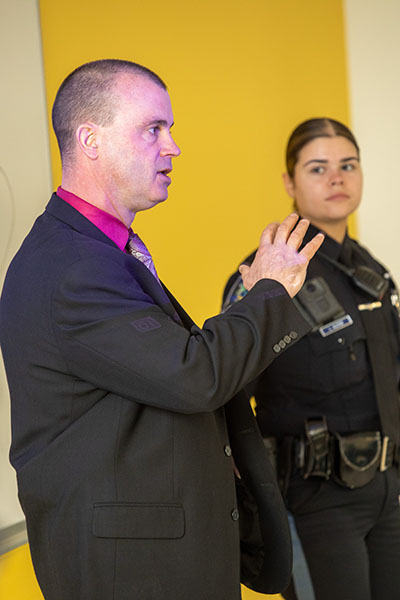- Apply
- Visit
- Request Info
- Give



Published on April 18, 2023
A new course at Eastern Connecticut State University that teaches students about the rigors of becoming a police officer recently concluded its pilot semester, giving students perspective as they consider law enforcement careers.
Titled “Pathways to Policing,” the course was mutually beneficial, said sociology Professor Theresa Severance, as it helps Eastern students becoming more employable while providing an opportunity for the police departments involved to “enhance their pool of candidates.”
Severance co-taught the course with Lt. Matt Solak of the Willimantic Police and Chief Stephen Tavares of Eastern’s Department of Public Safety. One student said the course was helpful to “understand the process of becoming a police officer in the state of Connecticut.”

Joining them at the last class of the semester were three other members of the Willimantic Police Department: Chief Paul Hussey, Officer Eric Myshrall and Recruit Officer Lacey Kloter ‘21.
Instructors touched on the basic nature of the job. Hussey stressed the importance of being “approachable” and “nice,” stating that policing is a customer service-oriented job: “It’s ‘how can I help you,’ not ‘what do you want?’”
Another point of emphasis in lectures was officer wellness. “I need to check in on my recruits constantly,” said Hussey, who was a K-9 handler for more than 10 years. “You’re a police officer and you’re there to help people and make people safer.
“At the end of the day, you’re a human being called on to do and see extraordinary things.”
“We’ve all seen horrible things that you can’t imagine,” said Myshrall, referencing a car accident in which a vehicle drove through downtown Willimantic at more than 100 miles per hour before flipping over.
In the final lecture of the semester, Solak instructed the students on field training, the next step after a recruit officer passes through a police academy and is hired by a department. A minimum of 400 hours of field training is required before a recruit can officially begin their policing career, said Solak.
The students also gained perspective from an Eastern alumna. Kloter ’23 holds a B.S. in sociology and criminology from Eastern and completed an internship with the Willimantic Police Department.
Kloter is currently undergoing field training. Her favorite part is receiving “feedback on every call (to action)” as she manages “being watched under a microscope.”
Pathways to Policing is on Eastern’s course schedule for the fall 2023 semester and is open to any student regardless of major or class standing.
Written by Noel Teter